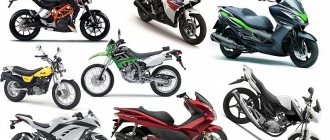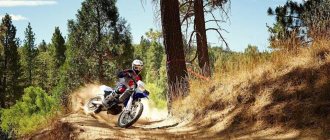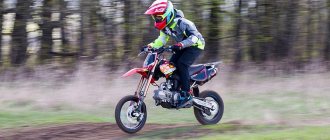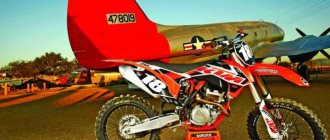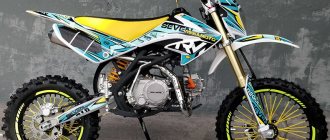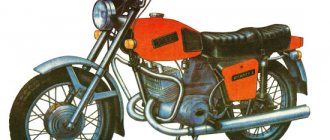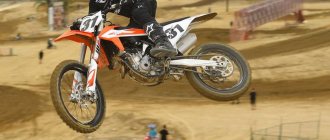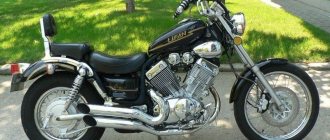Most pit bikes are designed for off-road riding, although there are also models designed for asphalt roads. Lightweight, compact and powerful, these mini-motorcycles are popular among bikers of all ages, and thanks to affordable prices, everyone can join this class of two-wheeled equipment. True, on public roads you can't ride them, since they are considered sports equipment and not a vehicle.
What is a pit bike for? To squeeze adrenaline out of him, what else? Don’t let the modest engine capacity typical of these babies deceive you – it is more than enough to please its owners. What is a pit bike? This is not a moped or a motorcycle, this is a completely different world, living by its own standards, and questions like “why is this needed if there is enduro?” inappropriate here.
The long path of pit bike evolution: from bicycle to motorcycle
Pitbike - what is it? Direct translation sounds like “technical boxing bike.” If we go deeper into history, we find out that pit bikes were a special type of equipment that was used by mechanics and maintenance personnel to move around the race track and the area where the teams’ pits were located (pit line).
The first pit bikes resembled bicycles; they were very chalk and unsafe, which in turn made it difficult to move along the highway. Over time, they were equipped with a motor, their power did not exceed 5 hp. But progress did not stand still; in the late 60s, the Japanese company Honda released new models of pit bikes, the Honda Super Cub 50 and Honda Z50 Mini Trail, which differed from their predecessors in their compactness and ease of maintenance.
Over time, this type of transport has evolved and nowadays a pit bike is no longer a bicycle, but a mini-motorcycle.
Interesting facts about a pit bike that you should know before purchasing
Before you learn to ride a pit bike, check out the following interesting facts :
- Due to the fact that a pit bike is a sports equipment, this type of equipment does not require registration with the traffic police and assignment of a license plate;
- Moreover, you don’t need a driver’s license to ride a pit bike;
- When choosing gasoline, the most optimal brand will be A92;
- The first time you need to change the oil for a pit bike is after 18 hours of riding. In the future - after every 35 hours of driving.
What should an adult choose?
Only the adult himself knows the answer to this question. Examples have already been given in the preface - for long-distance travel they take a tourist, for the forest - an enduro, for commuting to work... In the video below, my uncle at the age of 32 rode a motorcycle for the first time, and it was a PIT BIKE!
But when choosing, you should remember a few rules:
- Both pitas and crossbills are prohibited in urban areas . You can go to a village store if you don’t drive past the prosecutor’s dacha.
- Thanks to the development of this class, competitions, motocrosses, and races are also held on pit bikes . So riders don’t have to buy a motocross bike at all.
- Do you want to do stunts on motorcycles? A pit bike is more suitable for training . It’s lighter, the plastic can be removed, and it’s mentally easier to drop a cheap motorcycle!
- If the user has just opened the motorcycle, it is also better to start with the pit.
- And one last thing. Pit bikes have one serious drawback. Since the suspension was developed for a mini-motorcycle, the pilot’s weight should not exceed 80 kg . This parameter may not be indicated in the price lists, but if you want to use a pit bike for more than one season, you must definitely clarify the issue with the equipment seller. That is why it is recommended to take pitas new. For comparison, prices for a rear shock absorber start at 3,000 rubles, which is where the heaviest load is placed. Then the support bearings suffer.
Pitbike and enduro
Similarities
- Suitable for off-road driving.
Both bikes were designed for off-road riding. Of course, enduro behaves more confidently off-road. But a pit bike feels better in hard mud: its small size allows it not to get stuck in the mud, but to drive through it. - Easy to use.
Not only adults, but also teenagers, starting from 14 years old, can drive enduro. And pit bikes have long earned the reputation of “children’s” transport.
Differences
- Speed.
In terms of speed, pit bikes are definitely inferior to enduro, since the speed of the latter develops up to 160 km/h, while pit bikes do not accelerate above 100 km/h. - Water barriers.
Most pit bikes do not have an air box, and the filter is mounted on the carburetor. Because of this, the pit bike may react poorly to moisture. For enduro, water doesn't matter. - Maneuverability.
Pit bikes are much more maneuverable than enduro bikes. This is due to the lightweight design of pit bikes and the massiveness of enduro bikes. Thanks to this maneuverability, it is possible to train complex tricks and jumps on pit bikes, but this is not easy to do on enduro.
The best pit bikes
Of course, before any purchase, absolutely every person thinks about its quality and characteristics. Pit bikes are no exception to this. Naturally, you want to buy the best mini-motorcycle possible. But which one is he, the best? Of course, the best one will be the one that the person assembled himself, taking into account all the needs and wishes. However, this is not for everyone. Therefore, most people prefer to buy a ready-made mini-motorcycle rather than bother with assembling it in the garage.
First of all, before purchasing a mini-motorcycle, you should decide on its purpose - whether it is being purchased for professional sports, for learning to ride a motorcycle, or for a variety of tricks and entertainment. The only indisputable fact in any of the three options is that you will get 100% pleasure from riding a pit bike.
If we talk about the company and country of manufacture, then Japanese-made pit bikes are considered the best. The leaders here are four companies - Honda, Yamaha, Suzuki, Kawasaki. However, despite this, Chinese manufacturers are no less popular, among which it is worth mentioning Kayo, Irbis, BSE, Pitsterpro, etc. Not least occupied by the domestic manufacturer of pit bikes - Irbis. In general, motorcycles of the same class differ little from each other in their configuration. The only difference is the quality of the parts. Well, only the owner can decide which small iron horse is the best for certain purposes. As they say, to each his own.
In conclusion, it is worth saying that this motorcycle is a small, very comfortable, versatile motorcycle designed for off-road racing, which is capable of giving a sea of vivid impressions and unforgettable sensations to its owner from the first minute of riding it.
Choice by price
Since a pit bike is a relatively simple technique, prices for it start at 100 thousand rubles. In the range from 65 to 100 thousand there is a rather large selection of pit bikes with an engine capacity of 125 cubic meters. For example, the BSE brand has 8 models that fit within this budget.
The largest selection is in the range from 100 to 200 thousand: the range includes dozens of models from different brands. Light 125 cc pit bikes generally cost 100-120, 150 cc - from 110, and 250 cc - from 130-150 thousand.
Equipment more expensive than 200 thousand will most likely be either the most powerful, or the highest quality and reliable, or the most sophisticated in terms of configuration. Also, new models with a title (for example, the BSE M2 Y model with a volume of 250 “cubes”) usually cost significantly more than 200 thousand.
Common features of both types
Due to its low weight, even a child can handle this technique. The photo shows a beginner cross-country athlete.
The first and most important thing is light weight. If during the learning process you drop (or lay down) such a bike on the asphalt, it is easier to pick it up than a large tourist.
Cross bikes are made from lightweight materials, and a pit bike is a mini-motorcycle.
The second parameter is the comparable power of both types . While the former needs this to participate in competitions, the latter is only prevented from gaining speed up to 100 km by the pilot’s skills.
Cross versions are mainly 250 cc and two-stroke. Two-strokes produce more power and are more reliable.
The next parameter follows from the first two. This is the engine size . It's no secret that new engine models are being developed for racing motorcycles or existing ones are being boosted. The project is created in such a way as to produce high power with minimal volumes. You also rarely see a liter engine on a pit bike.
One more feature can be distinguished from the previous one. Less volume, less fuel consumption. You need refueling less often and you can travel more.
Difference in engines
Standard view of the engine of a Chinese pit bike. The photo shows our Regulmoto 125 cc.
Pit bikes mostly come with a 4-stroke engine, it is easier to maintain, but under serious loads it is more fragile than a 2-stroke cross bike.
Cross-country models are equipped with separate oil cooling, while pit bikes have only air cooling. This all affects the price . Well, the more parts, the greater the likelihood of breakdowns!
Most pit bikes have only air cooling.
You can see the additional cooling on the motocross bike. You can’t go anywhere without it, the loads are too big.
Motocross motorcycle or pit bike: so which is better?
The main distinguishing feature of motorcycles is the purpose of use. If we consider the best motocross motorcycle, it is important to understand that it is intended for motorsports and competitions on prepared tracks. Pit bikes are mini motorcycles that, unlike cross-country motorcycles, can be used to move around parks, squares or in the countryside.
If the question is about buying a motocross motorcycle or a pit bike, then you need to understand that the first one is not so easy to master, it will require special skills and practice. But the second one is quite easy to operate.
In this regard, we can conclude that the best motocross motorcycles are for professionals, and the best pit bikes are for amateurs.
The main differences between a pit bike and a motocross motorcycle
Despite some similarities between a pit bike and a motocross motorcycle, such as reduced dimensions, small engine capacity, power, and a ban on city driving, they also have some differences:
- Specifications:
| Name | Pitbike | Motocross bike |
| Motor type | Usually four-stroke | Single cylinder |
| Brakes | Improved | Regular disk |
| Suspension | Soft, since the main position is sitting | Rigid, designed for jumping and riding in standing positions |
| Wheels | Small (12 inches) | Large |
| Exhaust | Classical | Loud |
| Cooling system | Air and oil | Water/dry sump |
- Safety of use . Pit bikes are considered a more bladeless mode of transport due to their ease of use.
- Durability . The design of the pit bike uses fewer plastic parts, so in the event of a fall, breakdowns are less common.
- Price . The cost of a pit bike starts from 50 thousand rubles, but a minimum-spec motocross motorcycle will cost you from 100 thousand rubles.
- Difficulty of control . Driving the best motocross motorcycle requires a lot of practice, which cannot be said about a pit bike, which children can easily ride.
Is Chinese technology poor quality?
Indeed, the Avantis is made in China. But where did this stereotype come from, that “if it’s Chinese, it’s junk”? The price range of Avantis motorcycles is much lower than that of their Austrian, Swedish and Japanese counterparts, and the quality is far from worse.
Moreover, many American motorcycle manufacturers have been assembling their equipment in China for many years. Yes, and the Avantis is also no stranger to this market for a long time and has gained a reputation as a reliable pit bike with an acceptable price for the Republic of Belarus.
What is the scope of application?
Purchasing a pit bike is important for those who want to move around the city without difficulty avoiding traffic jams. That is why this technique is especially loved by couriers who deliver correspondence, goods, and food. The speed of order fulfillment is very high, and the cost of gasoline is minimal.
The fact that a pit bike is intended for only one person does not greatly hinder such workers, or even athletes participating in motocross. However, it should be taken into account that it is problematic to use transport in snow and ice, but in cities where, as a rule, the roads are cleaned and treated, problems should not arise.
Pitbike. How many cubes
Depending on the purpose of the pit bike, its power also varies. In general, pit bikes can be divided into three groups:
- Low-power. Motorcycles belonging to this group have an engine capacity from 50 to 110 cubic meters. They are well suited for novice motorcyclists, children or beginners in motorsports.
- Medium power. This class includes those equipped with an engine capacity of 125 to 140 cc. They are designed for both teenagers and adults.
- Powerful. They are already considered a serious technique, intended not only for participation in races, but also for performing various tricks. The engine capacity of powerful pit bikes is 160 cubic meters. A non-professional should not buy such equipment.
At the same time, you shouldn’t expect great speed even from the most powerful motorcycle of this type. The maximum speed of a pit bike is no more than 100 km/h. Therefore, it won’t be possible to “grip” on it.
Choosing a pit bike for yourself: taking into account important parameters
If you decide to buy a pit bike, then first of all read and take into account the list of important parameters before purchasing.
Speed shift system:
- Automatic;
- Semi-automatic;
- Manual.
Wheel diameter to driver height ratio:
- Models with a wheel diameter of 10-12 inches with a height of up to 120 cm;
- Models with a wheel diameter of 12-14 inches with a height of up to 120cm-150cm;
- Models with a wheel diameter of 14-17 inches with a height of up to 150cm-180cm;
- Models with a wheel diameter of 17 inches and larger with a height of 180 cm.
Divide your height by 2, this will give you an average saddle height that will be comfortable for you.
A pit bike is a vehicle designed for people with a maximum weight of up to 130 kg.
Engine power:
- Volume 50-110cm/cubic. Designed for children, as the maximum speed is 60 km/h;
- Volume 125-140cm/cubic. Designed for teenagers and drivers without experience. Maximum speed – 90 km/h;
- Volume 150-160cm/cubic. Such pit bikes are suitable for people with experience driving motorcycles;
- Volume 200-2500cm/cubic. Designed for professionals and off-road travel.
What to choose for a child?
When a child on a pit bike meets a traffic police inspector, there will definitely be problems!
Despite all of the above, parents may still have questions - what is the best gift for their child (from the classes described)?
The answer is actually simple. A beginner can only be offered one thing - a pit bike . Why?
- It will be easier for you to customize it to your child's skill level . There are models on the market where the gearbox can be reconfigured. From fully automatic, when you don’t need to worry about shifting, the electronics will do everything for the child, to conventional - sequential, when gears are changed with your foot.
- On some models you can block the upper speed limit . A good pit bike can reach up to 100 km/h . It's unlikely to be a good idea to let a little guy who only got behind the wheel yesterday drive at such a speed. (In the traffic rules, by the way, there is a point - if your driving experience is less than 2 years - do not exceed the speed above 70).
- Easy to start. It may be difficult for a child to hold the bike, hold down the brake, not touch the gas, and at the same time swing the kick starter foot with his foot. The main starting option used on pits is the starter button on the instrument panel. On a cross bike, you can remove the battery, lightening the weight, and start it with your foot.
Most pit bikes are equipped with an electric starter.
- From the point of view of the surface of movement, the pit bike is universal . It can be used both on an asphalt playground and on a grassy clearing in a park/forest. Light off-road conditions will not be an obstacle either. On asphalt, of course, it is better to change tires from mud to road, otherwise they will quickly wear out and become unusable.
- The speed of a serious cross-country motorcycle, for example the flagship Yamaxa R1, lies far beyond the 200 km mark. Whether a child needs a speed of two hundred kilometers is up to parents to decide.
Dimensions and weight
Pitbike. The length rarely exceeds 1900 mm, width - 850 mm, wheelbase - 1300 mm, weight - 80 kg. The most popular wheel sizes are 14/12″ and 17/14″ (the rear wheel is smaller than the front).
Motorbike. Even lightweight enduro models typically have a dry weight of over 100 kg. Road motorcycles with an engine capacity of up to 400 cm³ usually weigh between 130 and 200 kg. The heaviest motorcycles are touring motorcycles; their weight can reach 400 kg. In terms of dimensions, a small-capacity motorcycle is not much larger than a pit bike: on average, it has a length of 2000 mm, a width of 750 mm and a wheelbase of 1300 mm. The most popular wheel diameter is 17/17″.
What are the advantages?
Avantis pit bikes (yes, to be frank - not only Avantis) can serve you both for fun “rides” with friends and for serious competitions. Yes, yes - on such pit bikes you will be able to participate in various competitions and provide significant competition to the most expensive motorcycle brands.
Pit bikes are not heavy and compact. So, the average weight of a pit bike fluctuates around 70 kg and its dimensions will allow it to be transported by car (not in all cars, but still). The average pit bike can support a weight of approximately 130 kilograms.
In general, it is believed that someone who rides a pit bike should weigh less than 100 kg. So, if you are a “boar” weighing 100+ kilograms, look towards other motorcycles (we will look at everything on our blog).
Both adults and children can ride pit bikes . Moreover, it is believed that a pit bike is ideal for a teenager 9-15 years old. Which, in turn, makes it a good gift, and in many cases a way to distract a child from constantly sitting at the computer, drugs and... well, you understand everything yourself...
By the way, there are models of pit bikes (minimoto) for younger children. That is, this motorcycle is quite universal.
Features of pit bikes
Technical
Today, the market offers a huge variety of pit bikes from manufacturers from different countries. Basically, Chinese pit bikes are common. This is explained primarily by the price, because the same Japanese pit bikes cost the same as “adult” motocross motorcycles and are simply inaccessible to most pit bike buyers. In addition, the production of pit bikes is concentrated in China and even many European brands are assembled there.
Despite the abundance of different models, pit bikes are basically structurally similar and have a number of common features.
- Engine. A horizontally mounted engine, developed from the Honda Cub concept, with a horizontal cylinder arrangement.
- Engine capacity. The most popular engine displacements for pit bikes are 50, 125, 150 and 190 cc. cm. There are also pit bikes of 110, 140 and other intermediate cubic capacity values.
- Wheelbase. Increased wheelbase for a more comfortable fit for an adult and better handling when tall.
- Transmission. A manual transmission has a neutral position at the bottom according to the N-1-2-3-4 scheme, whereas on full-size motorcycles the neutral is located between 1st and 2nd gears. There are models with automatic and semi-automatic transmission.
- Wheels. The most popular wheel sizes (front/rear) are 10/10, 14/12 and 17/14 inches. Pit bikes with 14/12-inch wheels are considered “classics”.
- Suspension. Most often, an inverted fork is installed at the front, and a monoshock absorber without progression at the rear.
- Brakes. Mostly there are hydraulic disc brakes, but the smallest and cheapest ones can also have drum brakes.
- Rubber. Most models are equipped with “toothy” off-road tires, but there are also models with road tires for driving on asphalt.
- Cooling system. Pit bikes are more powerful - with a volume of 150 cc. see - usually have an oil cooler, the rest are cooled by a counter flow of air.
Legal
- Pit bikes are sports equipment; they are not a vehicle and are not certified for travel on public roads. They do not have a title, they cannot be registered with the traffic police and receive a license plate.
- As a result, a driver's license for a pit bike is not required. But you can only ride on specialized closed tracks and sports grounds.
Sports pit bike disciplines
Mini motocross
Among other pit bike disciplines, the most popular in the world is mini-motocross (mini-MX). This discipline completely repeats “classic motocross” with minor exceptions.
Firstly, the lap length is shorter for the safety of the riders and greater entertainment. Secondly, the figures on the tracks are smaller and adapted to the features of pit bikes to ensure safety when passing the track at high speed.
Major motocross competitions and championships may also feature pit bike races on the same tracks where dirt bikes compete. Usually in such cases the race takes place in a small circle of a large track. But the biggest test for both the rider and the pit bike is driving the entire length of the track.
In Russia, the most popular “pit bike” competition is held by the Pitbike Russia club on the track near the village of Gorki in the Moscow region. The event has the status of an unofficial Russian mini-motocross championship.
Mini-enduro, hard-enduro
Pit bikes are also used for enduro and hard enduro competitions, because... This technique is great for off-road use. Pit bikes cope well with rough terrain with fairly complex terrain. Forests, fields, sand pits, hills, river mouths - this is not what a pit bike is afraid of. But swamps and other muddy areas pose a danger to the pit bike due to air cooling. The system becomes clogged with dirt and cannot cope with its function, which can lead to engine overheating. In addition, the small size of the wheels has an effect, resulting in less cross-country ability. Therefore, the optimal wheel diameter for enduro is considered to be 17/14 inches.
Mini freestyle
With the growing popularity of “big” freestyle, there were people who wanted to test themselves in jumping and performing tricks on pit bikes.
As a rule, freestyle is performed on expensive pit bikes from well-known manufacturers with wheels with a diameter of 10/10 and 14/12 inches, guided by the principle - the better and more durable the bike, the safer the jumps. Sometimes there are athletes on pit bikes with 17/14-inch wheels.
Areas for freestyle riding on pit bikes are also being adapted - the size of the jumps is reduced, as in mini-cross. Jumping distances rarely exceed 10-12 m in length. In “adult” FMX they are much larger.
The pit bikes themselves undergo adaptation. Their design is strengthened so that it can withstand impacts from long amplitude jumps.
Even the relatively short jump distance does not prevent you from performing most of the “classic” tricks from the “big” freestyle, thanks to the light weight and size of the pit bikes.
In recent years, mini-freestyle has become increasingly popular throughout the world. Pitbikers perform at many international freestyle competitions, demonstrating spectacular tricks to the public.
Mini supermoto
The supermoto discipline is most like its “big brother.” The competitions take place on the same “full-size” circuit tracks, and the athletes’ equipment is the same.
Thanks to the mass distribution of pit bikes, the mini-supermoto discipline has changed beyond recognition. In many countries, pit bikes have replaced scooters, which were previously used in the mini-supermoto discipline, but were not very suitable due to their design, less power and high weight.
Races in this category are held on pit bikes of the “motard” type - they are equipped with slicks (rubber without tread) for better grip on asphalt and, as a rule, wheels of the same diameter. Pit bikes are often tuned, increasing engine power and handling at high speeds.
What competitions and types of pit bike riding are there?
Supermoto - riding on a flat surface, most often on asphalt. The most commonly used wheels are 12 inches in diameter.
Motocross is usually jumping hills and tracks for jumping on a pit bike. The most commonly used wheels are 12/14-inch in diameter and naturally with off-road tires.
Stunt – tricks on a flat surface (most often asphalt).
Park – skating in specialized parks, including skate parks, where various tricks are performed. In this kind of riding, they try to lighten the weight of the pit bike as much as possible.
The street is more like just riding through the streets on a pit bike without any restrictions. Natural urban elements in the form of curbs, railings, and stairs are used as obstacles. It is worth noting that this is prohibited in Belarus.
Freestyle moto – jumping on pit bikes, performing various figures in the air.
Pitbikes only for sport, entertainment and drive?
The point is that this is possible. Or it is possible, as in many European cities, where pit bikes are quite common as public transport. So, it is especially popular among couriers, postmen, and also for those who have to constantly travel and especially get stuck in traffic jams. Can you imagine these huge city traffic jams? And on a compact pit bike you will forget about them once and for all. In addition, a pit bike will go virtually anywhere. Even where a bicycle cannot pass. The only thing worth mentioning is that in Belarus there are a number of restrictions (driving in the city, on roads, etc.), which we will consider separately in the corresponding material.

